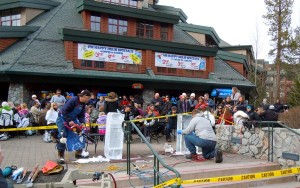North Shore launching free ski bus shuttle
By Kathryn Reed
STATELINE – Less than one hour before the Tahoe Transportation District board was to vote on creating a free ski bus shuttle on the North Shore, negotiations were still ongoing.
 This is because days before the Dec. 7 vote Northstar and Diamond Peak ski resorts backed out of their previous commitments. Squaw Valley-Alpine stepped in at the last minute with another $40,000 to ensure five of the six planned buses would be able to roll starting Dec. 22.
This is because days before the Dec. 7 vote Northstar and Diamond Peak ski resorts backed out of their previous commitments. Squaw Valley-Alpine stepped in at the last minute with another $40,000 to ensure five of the six planned buses would be able to roll starting Dec. 22.
“We actually are participating in the program. There is recognition that our already existing shuttle system plugs into the system that is being contemplated for the region. Our shuttles currently provide service to/from Incline Village and Tahoe Vista,” Jessica VanPernis with Northstar told Lake Tahoe News after the meeting.
However, the signs being devised won’t say Northstar.
TTD board President Steve Teshara acknowledged Northstar has a network of buses for its guests, but added that it is not part of the larger regional coordinated transit program that will be launched this month.
Northstar had originally committed to $86,800 for the coordinated program.
VanPernis said that offer was withdrawn “because our existing shuttle services are being utilized as part of the system being proposed.”
That is not at all how it was presented at last week’s meeting.
Brad Wilson, general manager at Diamond Peak, did not return a phone call. The Incline Village resort had originally said it would put up $7,700 for the shuttle.
Talks have been going on in earnest for the last year to devise such a ski bus shuttle, though people have actually been discussing it for the last 20 years.
“Resort operators realize you can go to other ski destinations and have this seamless transit,” Teshara told Lake Tahoe News. They wanted to finally implement such a service in Tahoe. Plus, North Shore has the largest concentration of resorts in North America.
The bus service will run on weekends and holiday weeks from Dec. 22-March 31.
Amador Stage Lines was awarded the contract at the Friday meeting. The main reason Amador won out over El Camino Charters is that they guaranteed, per stipulations by TTD, that each bus will be accessible by disabled people.
Buses will seat 38. Skiers and snowboarders will bring their equipment on board.
Funding comes from:
• Homewood Mountain Resort — $5,700
• Squaw Valley-Alpine Meadows — $169,000
• Truckee — $5,000
• North Lake Tahoe Resort Association — $65,900.
All but $20,000 of that total will go to the bus company. That $20,000 will be used for marketing and other expenses – which include signs.
Other ski areas are on the route – including Boreal, Royal Gorge, Donner Ski Ranch and Sugar Bowl.
There are more than 30 stops that ring the North Shore and jut into Truckee. The schedule is broken into morning and afternoon time periods.
Route and times may be found online.










